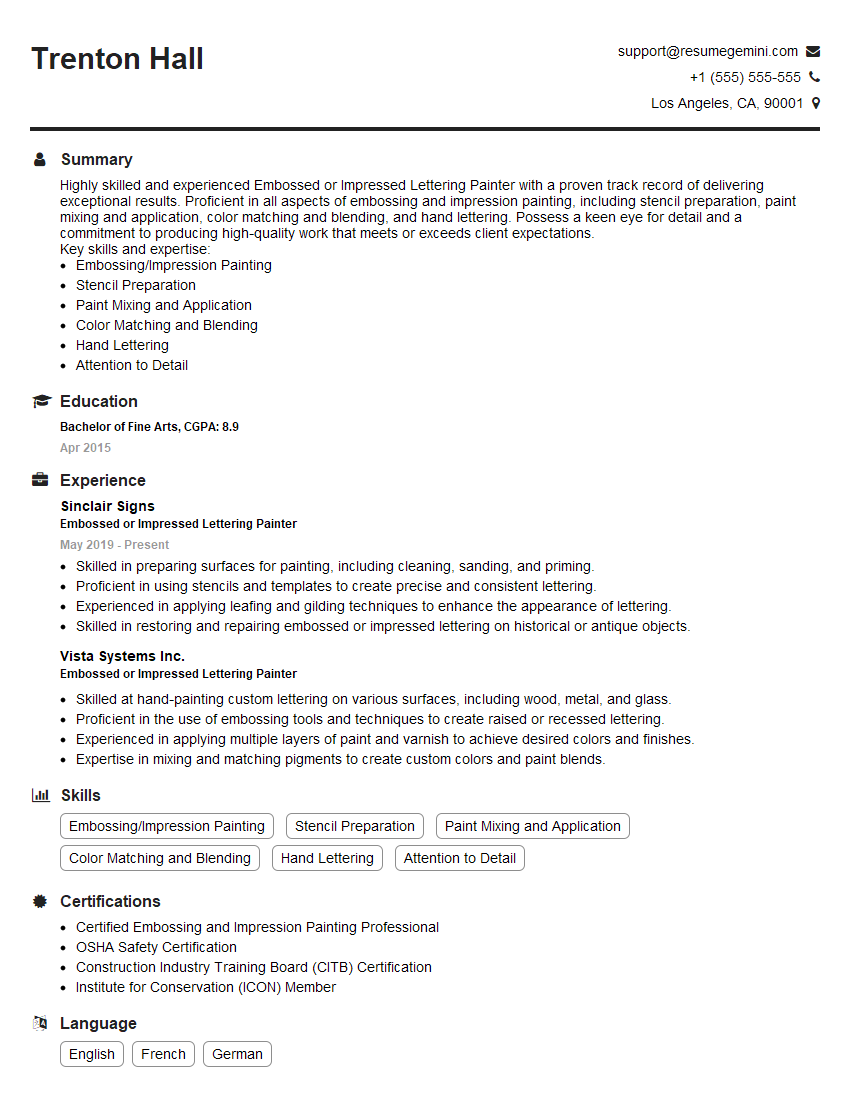Are you a seasoned Embossed or Impressed Lettering Painter seeking a new career path? Discover our professionally built Embossed or Impressed Lettering Painter Resume Template. This time-saving tool provides a solid foundation for your job search. Simply click “Edit Resume” to customize it with your unique experiences and achievements. Customize fonts and colors to match your personal style and increase your chances of landing your dream job. Explore more Resume Templates for additional options.

Trenton Hall
Embossed or Impressed Lettering Painter
Summary
Highly skilled and experienced Embossed or Impressed Lettering Painter with a proven track record of delivering exceptional results. Proficient in all aspects of embossing and impression painting, including stencil preparation, paint mixing and application, color matching and blending, and hand lettering. Possess a keen eye for detail and a commitment to producing high-quality work that meets or exceeds client expectations.
Key skills and expertise:
- Embossing/Impression Painting
- Stencil Preparation
- Paint Mixing and Application
- Color Matching and Blending
- Hand Lettering
- Attention to Detail
Education
Bachelor of Fine Arts
April 2015
Skills
- Embossing/Impression Painting
- Stencil Preparation
- Paint Mixing and Application
- Color Matching and Blending
- Hand Lettering
- Attention to Detail
Work Experience
Embossed or Impressed Lettering Painter
- Skilled in preparing surfaces for painting, including cleaning, sanding, and priming.
- Proficient in using stencils and templates to create precise and consistent lettering.
- Experienced in applying leafing and gilding techniques to enhance the appearance of lettering.
- Skilled in restoring and repairing embossed or impressed lettering on historical or antique objects.
Embossed or Impressed Lettering Painter
- Skilled at hand-painting custom lettering on various surfaces, including wood, metal, and glass.
- Proficient in the use of embossing tools and techniques to create raised or recessed lettering.
- Experienced in applying multiple layers of paint and varnish to achieve desired colors and finishes.
- Expertise in mixing and matching pigments to create custom colors and paint blends.
Certificates
- Certified Embossing and Impression Painting Professional
- OSHA Safety Certification
- Construction Industry Training Board (CITB) Certification
- Institute for Conservation (ICON) Member
Languages
- English
- French
- German
Career Expert Tips:
- Select the ideal resume template to showcase your professional experience effectively.
- Master the art of resume writing to highlight your unique qualifications and achievements.
- Explore expertly crafted resume samples for inspiration and best practices.
- Build your best resume for free this new year with ResumeGemini. Enjoy exclusive discounts on ATS optimized resume templates.
How To Write Resume For Embossed or Impressed Lettering Painter
- Highlight your technical skills and experience in embossing/impression painting.
- Showcase your artistic ability and creativity through a portfolio of your work.
- Demonstrate your attention to detail and commitment to quality.
- Tailor your resume to each job application, emphasizing the skills and experience that are most relevant to the role.
Essential Experience Highlights for a Strong Embossed or Impressed Lettering Painter Resume
- Prepare stencils and paint mixtures for embossing and impression painting projects.
- Apply paint to surfaces using various techniques, including brushing, rolling, and spraying.
- Match and blend colors to achieve desired effects.
- Create and execute hand-lettered designs and inscriptions.
- Inspect finished products to ensure quality and accuracy.
- Maintain a clean and organized work area.
Frequently Asked Questions (FAQ’s) For Embossed or Impressed Lettering Painter
What is the primary role of an Embossed or Impressed Lettering Painter?
Embossed or Impressed Lettering Painters use specialized techniques to create raised or recessed lettering and designs on various surfaces. They prepare stencils, mix and apply paint, match colors, and execute hand-lettered designs to achieve visually appealing and durable results.
What skills are essential for success as an Embossed or Impressed Lettering Painter?
Embossing or Impression Lettering Painters require a combination of technical skills, including stencil preparation, paint application, color matching, and hand lettering. They must also possess a keen eye for detail, a steady hand, and a commitment to producing high-quality work.
What industries employ Embossed or Impressed Lettering Painters?
Embossed or Impressed Lettering Painters find employment in various industries, including signage companies, manufacturing, construction, and retail. They may work on projects ranging from storefront signs and vehicle graphics to architectural elements and decorative pieces.
What are the career prospects for Embossed or Impressed Lettering Painters?
Embossed or Impressed Lettering Painters with strong skills and experience can advance to lead roles within their companies or pursue specialized areas such as sign restoration or custom lettering. They may also start their own businesses.
What is the earning potential for Embossed or Impressed Lettering Painters?
The earning potential for Embossed or Impressed Lettering Painters varies depending on factors such as experience, skills, industry, and location. According to Indeed, the average salary for an Embosser in the United States is around $42,000 per year.
What are the working conditions like for Embossed or Impressed Lettering Painters?
Embossed or Impressed Lettering Painters typically work in workshops or studios, often standing for extended periods. They may also work outdoors on-site for large-scale projects. The job requires attention to detail and precision, and safety precautions must be followed when working with paints and chemicals.
How can I become an Embossed or Impressed Lettering Painter?
There is no specific educational requirement to become an Embossed or Impressed Lettering Painter. However, obtaining a degree in Fine Arts or Graphic Design can provide a strong foundation in art and design principles. Additionally, completing an apprenticeship or working under an experienced professional can help develop the necessary skills and techniques.